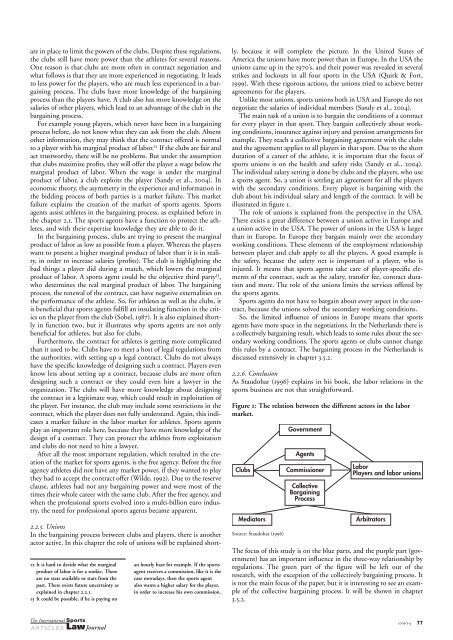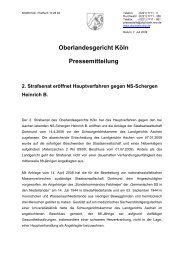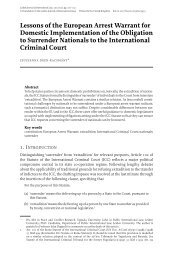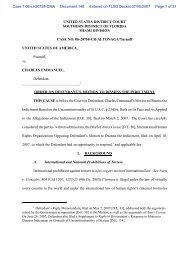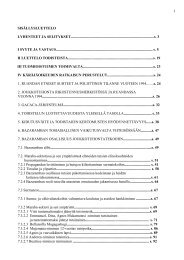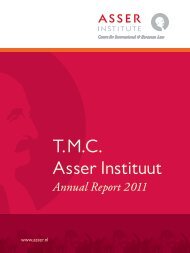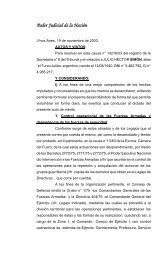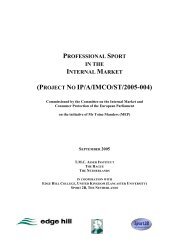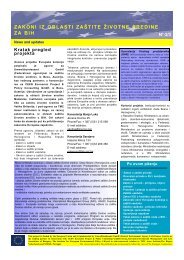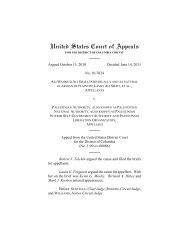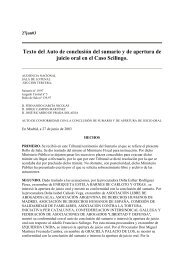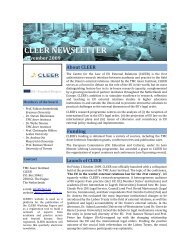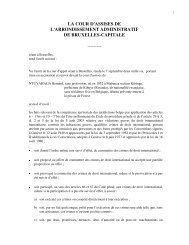Islj 2009 3-4 - TMC Asser Instituut
Islj 2009 3-4 - TMC Asser Instituut
Islj 2009 3-4 - TMC Asser Instituut
You also want an ePaper? Increase the reach of your titles
YUMPU automatically turns print PDFs into web optimized ePapers that Google loves.
are in place to limit the powers of the clubs. Despite these regulations,<br />
the clubs still have more power than the athletes for several reasons.<br />
One reason is that clubs are more often in contract negotiation and<br />
what follows is that they are more experienced in negotiating. It leads<br />
to less power for the players, who are much less experienced in a bargaining<br />
process. The clubs have more knowledge of the bargaining<br />
process than the players have. A club also has more knowledge on the<br />
salaries of other players, which lead to an advantage of the club in the<br />
bargaining process.<br />
For example young players, which never have been in a bargaining<br />
process before, do not know what they can ask from the club. Absent<br />
other information, they may think that the contract offered is normal<br />
to a player with his marginal product of labor. 12 If the clubs are fair and<br />
act trustworthy, there will be no problems. But under the assumption<br />
that clubs maximize profits, they will offer the player a wage below the<br />
marginal product of labor. When the wage is under the marginal<br />
product of labor, a club exploits the player (Sandy et al., 2004). In<br />
economic theory, the asymmetry in the experience and information in<br />
the bidding process of both parties is a market failure. This market<br />
failure explains the creation of the market of sports agents. Sports<br />
agents assist athletes in the bargaining process, as explained before in<br />
the chapter 2.1. The sports agents have a function to protect the athletes,<br />
and with their expertise knowledge they are able to do it.<br />
In the bargaining process, clubs are trying to present the marginal<br />
product of labor as low as possible from a player. Whereas the players<br />
want to present a higher marginal product of labor than it is in reality,<br />
in order to increase salaries (profits). The club is highlighting the<br />
bad things a player did during a match, which lowers the marginal<br />
product of labor. A sports agent could be the objective third party 13 ,<br />
who determines the real marginal product of labor. The bargaining<br />
process, the renewal of the contract, can have negative externalities on<br />
the performance of the athlete. So, for athletes as well as the clubs, it<br />
is beneficial that sports agents fulfill an insulating function in the critics<br />
on the player from the club (Sobel, 1987). It is also explained shortly<br />
in function two, but it illustrates why sports agents are not only<br />
beneficial for athletes, but also for clubs.<br />
Furthermore, the contract for athletes is getting more complicated<br />
than it used to be. Clubs have to meet a host of legal regulations from<br />
the authorities, with setting up a legal contract. Clubs do not always<br />
have the specific knowledge of designing such a contract. Players even<br />
know less about setting up a contract, because clubs are more often<br />
designing such a contract or they could even hire a lawyer in the<br />
organization. The clubs will have more knowledge about designing<br />
the contract in a legitimate way, which could result in exploitation of<br />
the player. For instance, the club may include some restrictions in the<br />
contract, which the player does not fully understand. Again, this indicates<br />
a market failure in the labor market for athletes. Sports agents<br />
play an important role here, because they have more knowledge of the<br />
design of a contract. They can protect the athletes from exploitation<br />
and clubs do not need to hire a lawyer.<br />
After all the most important regulation, which resulted in the creation<br />
of the market for sports agents, is the free agency. Before the free<br />
agency athletes did not have any market power, if they wanted to play<br />
they had to accept the contract offer (Wilde, 1992). Due to the reserve<br />
clause, athletes had not any bargaining power and were most of the<br />
times their whole career with the same club. After the free agency, and<br />
when the professional sports evolved into a multi-billion euro industry,<br />
the need for professional sports agents became apparent.<br />
12 It is hard to decide what the marginal<br />
product of labor is for a rookie. There<br />
are no stats available or stats from the<br />
past. There exists future uncertainty as<br />
explained in chapter 2.2.1.<br />
13 It could be possible, if he is paying on<br />
an hourly base for example. If the sports<br />
agent receives a commission, like it is the<br />
case nowadays, then the sports agent<br />
also wants a higher salary for the player,<br />
in order to increase his own commission.<br />
2.2.5. Unions<br />
In the bargaining process between clubs and players, there is another<br />
actor active. In this chapter the role of unions will be explained shortly,<br />
because it will complete the picture. In the United States of<br />
America the unions have more power than in Europe. In the USA the<br />
unions came up in the 1970’s, and their power was revealed in several<br />
strikes and lockouts in all four sports in the USA (Quirk & Fort,<br />
1999). With these rigorous actions, the unions tried to achieve better<br />
agreements for the players.<br />
Unlike most unions, sports unions both in USA and Europe do not<br />
negotiate the salaries of individual members (Sandy et al., 2004).<br />
The main task of a union is to bargain the conditions of a contract<br />
for every player in that sport. They bargain collectively about working<br />
conditions, insurance against injury and pension arrangements for<br />
example. They reach a collective bargaining agreement with the clubs<br />
and the agreement applies to all players in that sport. Due to the short<br />
duration of a career of the athlete, it is important that the focus of<br />
sports unions is on the health and safety risks (Sandy et al., 2004).<br />
The individual salary setting is done by clubs and the players, who use<br />
a sports agent. So, a union is settling an agreement for all the players<br />
with the secondary conditions. Every player is bargaining with the<br />
club about his individual salary and length of the contract. It will be<br />
illustrated in figure 1.<br />
The role of unions is explained from the perspective in the USA.<br />
There exists a great difference between a union active in Europe and<br />
a union active in the USA. The power of unions in the USA is larger<br />
than in Europe. In Europe they bargain mainly over the secondary<br />
working conditions. These elements of the employment relationship<br />
between player and club apply to all the players. A good example is<br />
the safety, because the safety net is important of a player, who is<br />
injured. It means that sports agents take care of player-specific elements<br />
of the contract, such as the salary, transfer fee, contract duration<br />
and more. The role of the unions limits the services offered by<br />
the sports agents.<br />
Sports agents do not have to bargain about every aspect in the contract,<br />
because the unions solved the secondary working conditions.<br />
So, the limited influence of unions in Europe means that sports<br />
agents have more space in the negotiations. In the Netherlands there is<br />
a collectively bargaining result, which leads to some rules about the secondary<br />
working conditions. The sports agents or clubs cannot change<br />
this rules by a contract. The bargaining process in the Netherlands is<br />
discussed extensively in chapter 3.5.2.<br />
2.2.6. Conclusion<br />
As Staudohar (1996) explains in his book, the labor relations in the<br />
sports business are not that straightforward.<br />
Figure 1: The relation between the different actors in the labor<br />
market.<br />
Source: Staudohar (1996)<br />
The focus of this study is on the blue parts, and the purple part (government)<br />
has an important influence in the three-way relationship by<br />
regulations. The green part of the figure will be left out of the<br />
research, with the exception of the collectively bargaining process. It<br />
is not the main focus of the paper, but it is interesting to see an example<br />
of the collective bargaining process. It will be shown in chapter<br />
3.5.2.<br />
A RT I C L E S<br />
<strong>2009</strong>/3-4 77


